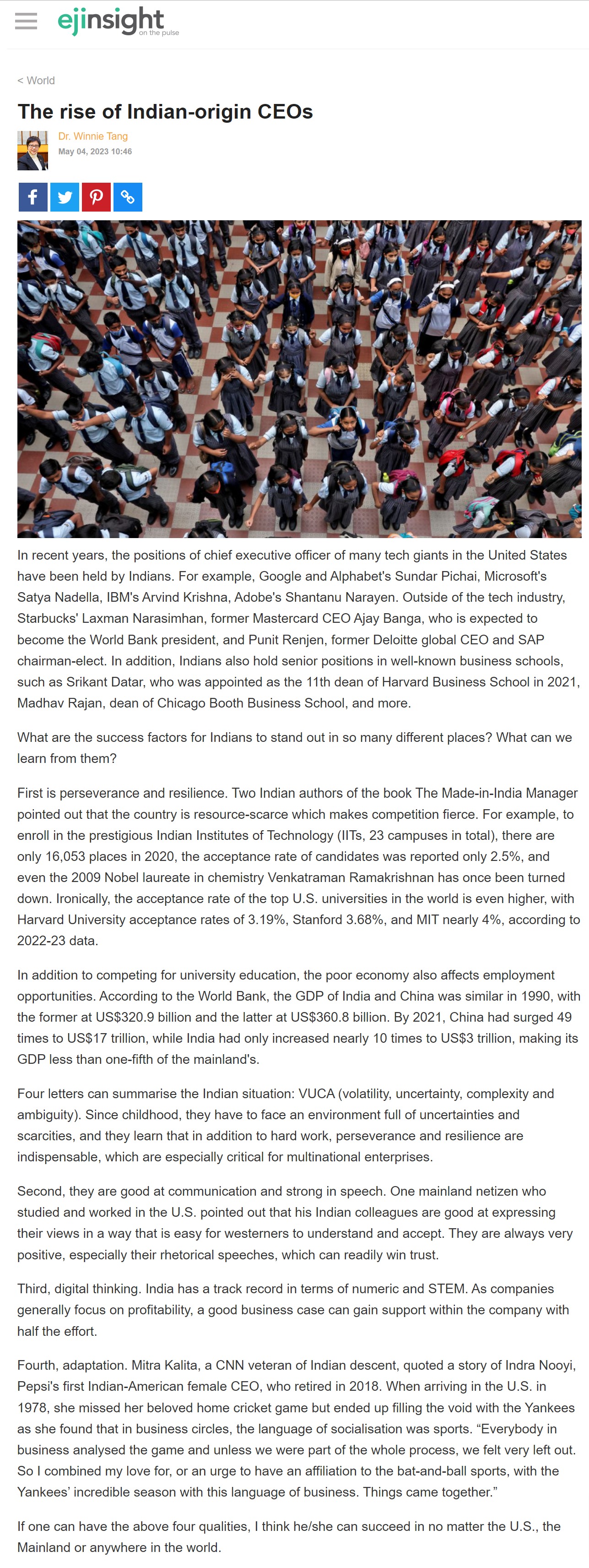網上版請按此

The rise of Indian-origin CEOs
In recent years, the positions of chief executive officer of many tech giants in the United States have been held by Indians. For example, Google and Alphabet's Sundar Pichai, Microsoft's Satya Nadella, IBM's Arvind Krishna, Adobe's Shantanu Narayen. Outside of the tech industry, Starbucks' Laxman Narasimhan, former Mastercard CEO Ajay Banga, who is expected to become the World Bank president, and Punit Renjen, former Deloitte global CEO and SAP chairman-elect. In addition, Indians also hold senior positions in well-known business schools, such as Srikant Datar, who was appointed as the 11th dean of Harvard Business School in 2021, Madhav Rajan, dean of Chicago Booth Business School, and more.
What are the success factors for Indians to stand out in so many different places? What can we learn from them?
First is perseverance and resilience. Two Indian authors of the book The Made-in-India Manager pointed out that the country is resource-scarce which makes competition fierce. For example, to enroll in the prestigious Indian Institutes of Technology (IITs, 23 campuses in total), there are only 16,053 places in 2020, the acceptance rate of candidates was reported only 2.5%, and even the 2009 Nobel laureate in chemistry Venkatraman Ramakrishnan has once been turned down. Ironically, the acceptance rate of the top U.S. universities in the world is even higher, with Harvard University acceptance rates of 3.19%, Stanford 3.68%, and MIT nearly 4%, according to 2022-23 data.
In addition to competing for university education, the poor economy also affects employment opportunities. According to the World Bank, the GDP of India and China was similar in 1990, with the former at US$320.9 billion and the latter at US$360.8 billion. By 2021, China had surged 49 times to US$17 trillion, while India had only increased nearly 10 times to US$3 trillion, making its GDP less than one-fifth of the mainland's.
Four letters can summarise the Indian situation: VUCA (volatility, uncertainty, complexity and ambiguity). Since childhood, they have to face an environment full of uncertainties and scarcities, and they learn that in addition to hard work, perseverance and resilience are indispensable, which are especially critical for multinational enterprises.
Second, they are good at communication and strong in speech. One mainland netizen who studied and worked in the U.S. pointed out that his Indian colleagues are good at expressing their views in a way that is easy for westerners to understand and accept. They are always very positive, especially their rhetorical speeches, which can readily win trust.
Third, digital thinking. India has a track record in terms of numeric and STEM. As companies generally focus on profitability, a good business case can gain support within the company with half the effort.
Fourth, adaptation. Mitra Kalita, a CNN veteran of Indian descent, quoted a story of Indra Nooyi, Pepsi's first Indian-American female CEO, who retired in 2018. When arriving in the U.S. in 1978, she missed her beloved home cricket game but ended up filling the void with the Yankees as she found that in business circles, the language of socialisation was sports. "Everybody in business analysed the game and unless we were part of the whole process, we felt very left out. So I combined my love for, or an urge to have an affiliation to the bat-and-ball sports, with the Yankees' incredible season with this language of business. Things came together."
If one can have the above four qualities, I think he/she can succeed in no matter the U.S., the Mainland or anywhere in the world.
Dr. Winnie Tang
Adjunct Professor, Department of Computer Science, Faculty of Engineering; Department of Geography, Faculty of Social Sciences; and Faculty of Architecture, The University of Hong Kong